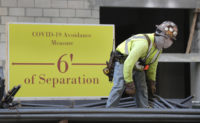Medical Emergencies
Texas Trauma Unit Fields Regular Calls From Construction

In May, the Frisco, Texas, fire department called Mark Gamber, a critical-care physician and the intensive care unit director at Medical City Plano, a big hospital that is about a 15-mile, 20-minute drive from the hospital on the Dallas North Tollway. There had been a construction accident.
"A man's pants got pulled up into a trencher machine, causing significant lower extremity injuries," Gamber says. "They knew they weren't going to be able to get him out."
The call represented one of the first tests of the Medical Center's rapidly deployed mobile surgical capability at a construction project since its trauma unit achieved Level 1 status last year. The kind of emergency medicine it practices has been needed repeatedly during the region's current construction boom.
Gamber says his team brings an operating-room level of care to the jobsites.
The decision to form the team was made earlier this year because the booming economy in North Texas is producing more construction injuries.
The hospital decided to form the team earlier this year because "there's a booming economy in North Texas; we're seeing a lot more construction injuries," Gamber says.
Limb and extremity injuries requiring amputation are a constant hazard in construction. According to the U.S. Bureau of Labor Statistics, there were about 550 construction-related amputations in 2015.
In recent days, for example, the project manager for a demolition contractor lost a leg when a building collapsed unexpectedly.
When Medical City Plano became a level-one trauma center last year, it committed to staff the trauma unit with more than one surgeon at all times. That way, Gamber notes, the hospital is covered when a surgeon is called out into the field.
On the day of the accident in May, trauma and acute care surgeon Al West "hitched a ride on a helicopter" to the site, bringing a toolbox of equipment and a cooler full of blood, according to Gamber. The injured worker, Francisco Palma, had lost a lot of blood and needed a transfusion. Gamber, who arrived with firefighters, assisted West in amputating one of Palma's legs.
The helicopter carried them back to Medical City Plano's emergency room. A series of follow-up trips to the operating room were planned to rid Palma's wounds of possible bacteria.
"There's a lot we've learned from the military that we put into play," Gamber says. "We used tourniquets, which used to be considered a bad idea but now is seen as good."
Pain Control Drug Experience
Another thing trauma teams have learned from the military, according to Gamber, is the value of ketamine, a drug that induces a trance-like state while providing pain relief, sedation and memory loss. "It's like a Swiss army knife. It made this guy sleepy and controlled his pain. The medics were able to provide great pain control."
Gamber urges construction companies to develop relationships with trauma centers near where they operate. "Find out if they have a program like this. There is no extra cost to company. Ask them: Could you do this? Could we utilize this?"
Rade B. Vukmir, a physician, also advises construction companies to cooperate with trauma centers. Vukmir is national medical director of critical-care medicine and chief clinical officer of patient-safety organization for the healthcare organization Schumacher Clinical Partners.
"Evaluate your local resources, work with your local EMS to make sure there is a protocol in place and that resources would be available when needed," says Vukmir, who took part in a field amputation in the mid 1990s when a worker was trapped in an auger.
In recent years, according to Vukmir, great advances have been made in pre-hospital amputations, thanks to experience gained by the military and by surgeons working at disaster sites.
For construction-site applications "there needs to be a dedicated team and a written protocol. This not the kind of thing you kind of freelance," he says. "You need to have thought this through."


